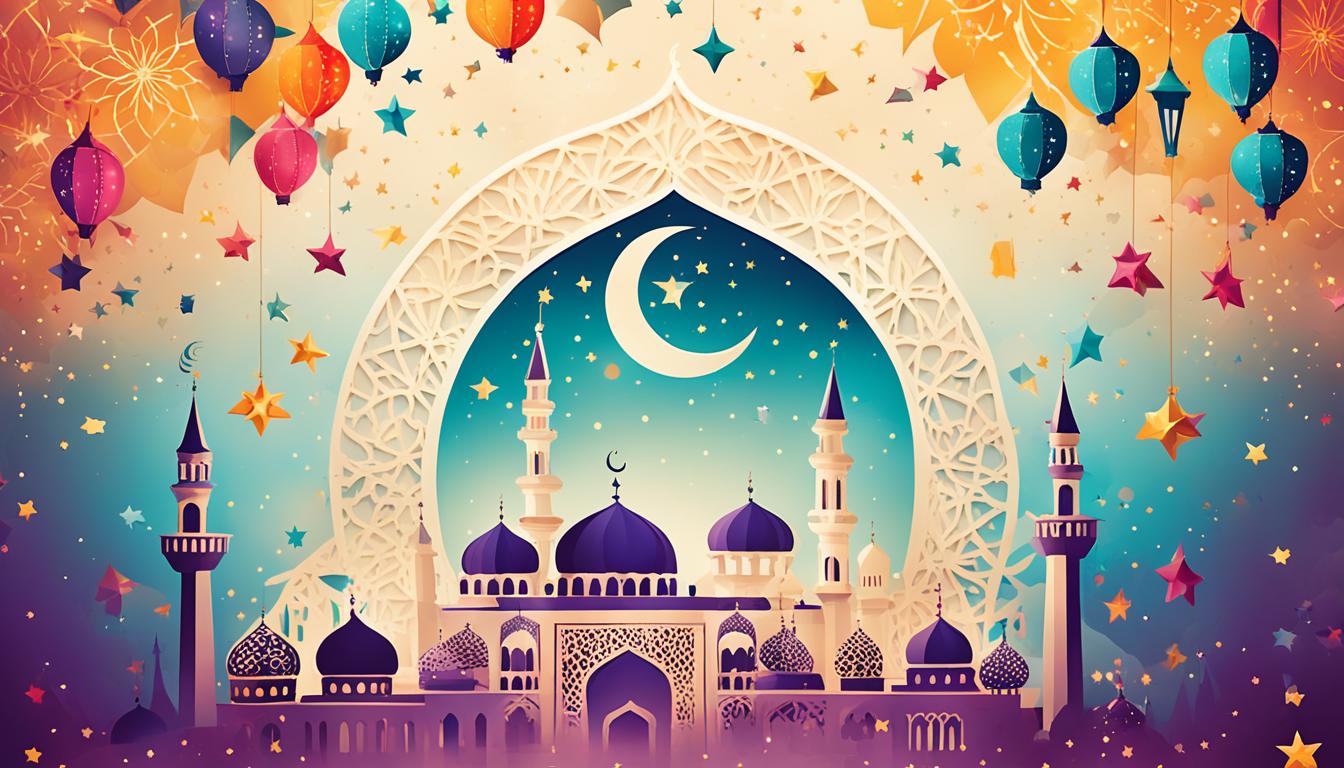Ever wondered why folks say **”Eid Mubarak”**? It’s not just any phrase. For Muslims everywhere, it marks the **joyful celebrations** of Eid al-Fitr and Eid al-Adha. But what’s the real scoop on “Eid Mubarak”? This little saying packs **big** cultural and religious **importance**. Ready to dive into its fascinating meaning?
Key Takeaways:
- Eid Mubarak is an Arabic phrase that means “Blessed feast/festival.”
- It is used by Muslims worldwide to celebrate Eid al-Fitr and Eid al-Adha.
- Eid Mubarak is a cultural tradition that holds regional variations in different Muslim communities.
The Regional Variations of Eid Mubarak
In different regions and Muslim communities, there are variations of Eid Mubarak greetings. While Arab Muslims primarily use Eid Mubarak, there are other ways to extend happy holiday wishes.
Persian speakers in Iran, Afghanistan, and Tajikistan use phrases like “eid-e shoma mobarak” or “eid mobarak.” Kurds have their own unique variations such as “jazhin piroz” and “jazhn-a we piroz.” Bosnian Muslims commonly say “Bajram Šerif mubarek olsun.” Turks in Turkey and Azerbaijan have Turkish phrases for Eid greetings.
In South Asia, Urdu speakers use “Khair Mubarak” as a common response to Eid greetings. In Bangladesh, the Bengali phrase “Eider Shubhechchha” is more prevalent. Meanwhile, in Southeast Asia, Malay speakers use “Selamat Hari Raya.” The greeting “Eid Mubarak” has also gained popularity among Filipino Muslims in the Philippines.
In West Africa, Hausa speakers greet with “Barka da Sallah,” while in Latin America and Spain, “Feliz Eid” is commonly used. Additionally, Albanians and Kosovar Muslims use “Urime festa e fitër Bajramit” and “Urime kurban bajrami” respectively as part of their Eid Mubarak greetings.
| Muslim Community/Region | Eid Mubarak Greetings |
|---|---|
| Arab Muslims | Eid Mubarak |
| Persian speakers | “eid-e shoma mobarak” or “eid mobarak” |
| Kurds | “jazhin piroz” and “jazhn-a we piroz” |
| Bosnian Muslims | “Bajram Šerif mubarek olsun” |
| Turk Muslims | Turkish phrases |
| South Asia (Urdu speakers in Pakistan) | “Khair Mubarak” |
| Bangladesh | “Eider Shubhechchha” |
| Southeast Asia (Malay speakers) | “Selamat Hari Raya” |
| Philippines | “Eid Mubarak” |
| West Africa (Hausa speakers) | “Barka da Sallah” |
| Latin America and Spain | “Feliz Eid” |
| Albania | “Urime festa e fitër Bajramit” |
| Kosovo | “Urime kurban bajrami” |
Eid Mubarak greetings showcase the rich diversity and cultural traditions that exist within various Muslim communities and regions.
Saying Eid Mubarak to Non-Muslims
While celebrating Eid Mubarak is primarily a custom among Muslims, the spirit of this joyous occasion can be extended to people from every culture. Muslims often graciously say Eid Mubarak to individuals in their community, irrespective of their religious background, expressing goodwill and inclusiveness. Non-Muslims who wish Muslims Eid Mubarak are generally met with appreciation and gratitude.
During the celebrations of Eid, it is important to use the phrase Eid Mubarak when expressing wishes to individuals from different cultures. This act of kindness and respect bridges the gap between communities and fosters a sense of unity. By extending Eid Mubarak to non-Muslims, it demonstrates the universal values of love, compassion, and shared celebrations that transcend religious boundaries.
Embracing diversity and fostering cultural understanding is a testament to the true spirit of Eid. Saying Eid Mubarak to non-Muslims not only acknowledges their presence during this festive time but also allows for meaningful connections to be made, creating a sense of harmony and solidarity.
Every culture has its unique way of celebrating special occasions, and sharing the joy and blessings of Eid Mubarak across cultural lines adds richness and depth to the collective human experience. By recognizing and respecting the traditions of others, we can build bridges of understanding and promote a sense of togetherness.
So, during this Eid, let us celebrate the diversity that enriches our world by extending Eid Mubarak to people of every culture. By embracing one another and exchanging heartfelt greetings, we can create a more inclusive and harmonious society.
It’s important to remember that Eid Mubarak is not limited to a particular religion but represents the shared values of love, peace, and celebration that resonate with people from all walks of life. By extending Eid Mubarak to non-Muslims, we embrace the beauty of diversity and cultivate a more inclusive and compassionate world.
To visually complement the essence of extending Eid Mubarak to people of every culture, here is an image depicting a diverse group of individuals sharing heartfelt greetings:

Using Eid Mubarak and Its Variations
Eid Mubarak is a versatile greeting that can be used in various contexts to wish others a happy Eid. Whether it’s spoken as a formal greeting or shared in passing during festive celebrations, Eid Mubarak is an integral part of expressing blessings and well-wishes. To fully embrace the cultural significance of Eid Mubarak, it’s important to understand how to use it correctly and respectfully.
Using Eid Mubarak as a Greeting
When extending Eid Mubarak greetings, one can simply say “Eid Mubarak” or use the elongated version that specifies the festival being celebrated, such as “Eid al-Fitr Mubarak” or “Eid al-Adha Mubarak.” This allows for a more personalized greeting that acknowledges the specific occasion.
Example: “Wishing you a joyous Eid al-Fitr Mubarak filled with love and happiness!”
Practicing Eid Mubarak Pronunciation
Pronouncing Eid Mubarak accurately helps convey sincerity and respect in the greeting. The correct pronunciation is “eed Mu-ba-rack,” with emphasis on the “-barack” syllable. Practicing the pronunciation ensures that the greeting is delivered with confidence and authenticity.
Using Eid Mubarak During Celebrations
During Eid celebrations, the use of Eid Mubarak is common and encouraged. It is customary to greet friends, family, and community members with the phrase as a way of spreading joy and unity. By incorporating Eid Mubarak into conversations and interactions, individuals actively participate in the festive spirit of the occasion.
Responding to Eid Mubarak
When someone greets you with Eid Mubarak, it is customary to respond with gratitude and well-wishes. Common responses include “Khair Mubarak,” which means “blessed Eid to you,” or “JazakAllah Khair,” which means “thank you, may Allah reward you with goodness.” These responses express appreciation and reciprocate the good wishes received.
By understanding and utilizing the correct usage, pronunciation, and responses associated with Eid Mubarak, individuals can fully engage in the cultural significance of the greeting. It serves as a means of fostering connections, bridging cultural gaps, and spreading joy during the cherished celebrations of Eid.
| Key Points | Keywords |
|---|---|
| 1. Eid Mubarak is a versatile greeting used to wish others a happy Eid. | how to use Eid Mubarak |
| 2. Practice the correct pronunciation of Eid Mubarak as “eed Mu-ba-rack.” | Eid Mubarak pronunciation, practicing Eid Mubarak pronunciation |
| 3. Use Eid Mubarak as a formal greeting or in passing during festive celebrations. | using Eid Mubarak during celebrations |
| 4. Respond to Eid Mubarak with gratitude and well-wishes. | responding to Eid Mubarak |

Understanding Eid al-Fitr
Eid al-Fitr holds great significance in the Islamic Calendar as it commemorates the end of Ramadan, a month of fasting, and celebrates the accomplishment of abstaining from food and drink from sunrise to sunset. This joyous occasion is a time for Muslims to come together with their loved ones, partake in festive meals, and exchange gifts as a reflection of gratitude and unity.
The date of Eid al-Fitr is determined by the sighting of the moon, making it a dynamic event that falls on different days each year. This annual celebration marks the conclusion of Ramadan and typically lasts for three days, providing an opportunity for Muslims to indulge in the festivities and rejoice in their spiritual fulfillment.
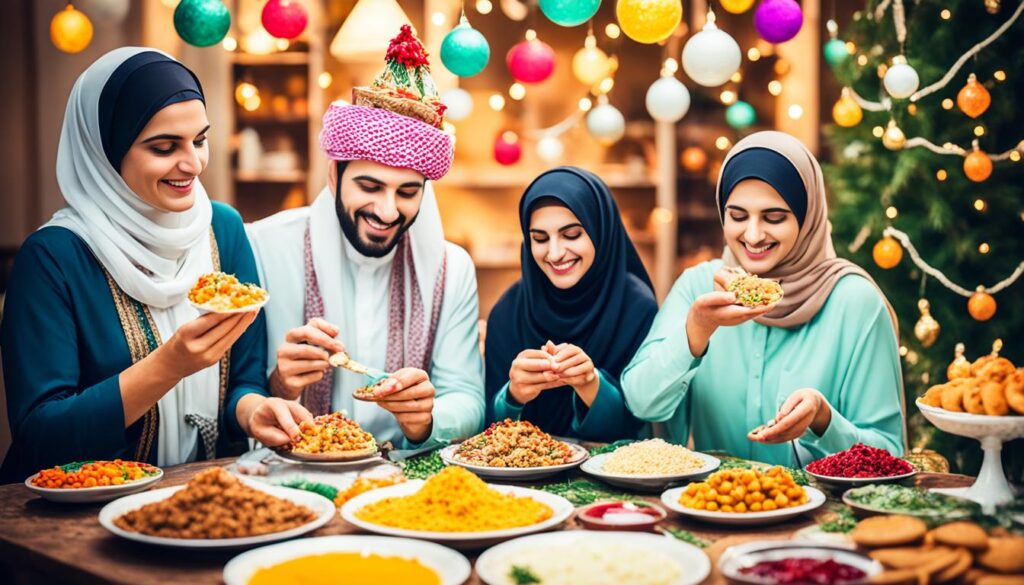
How to Respond to Eid Mubarak
When greeted with Eid Mubarak, it is important to respond with appropriate and respectful phrases. Muslim individuals commonly reply with phrases like “Khair Mubarak” or “JazakAllah Khair.” These responses express gratitude and reciprocate the good wishes extended during the celebrations of Eid.
Responding with “Khair Mubarak” conveys blessings in return and shows appreciation for the well-wishes received. Alternatively, responding with “JazakAllah Khair” expresses gratitude and acknowledges the sender’s kindness. Both responses are widely used and well-received by Muslims, reflecting the spirit of unity and joy that surrounds the festive occasion of Eid.
When responding to Eid Mubarak, it is essential to maintain a respectful tone and consider the religious and cultural significance of the greeting. By reciprocating the greetings with sincere and appropriate responses, individuals can contribute to fostering positive and inclusive interactions during the joyous festivities of Eid.
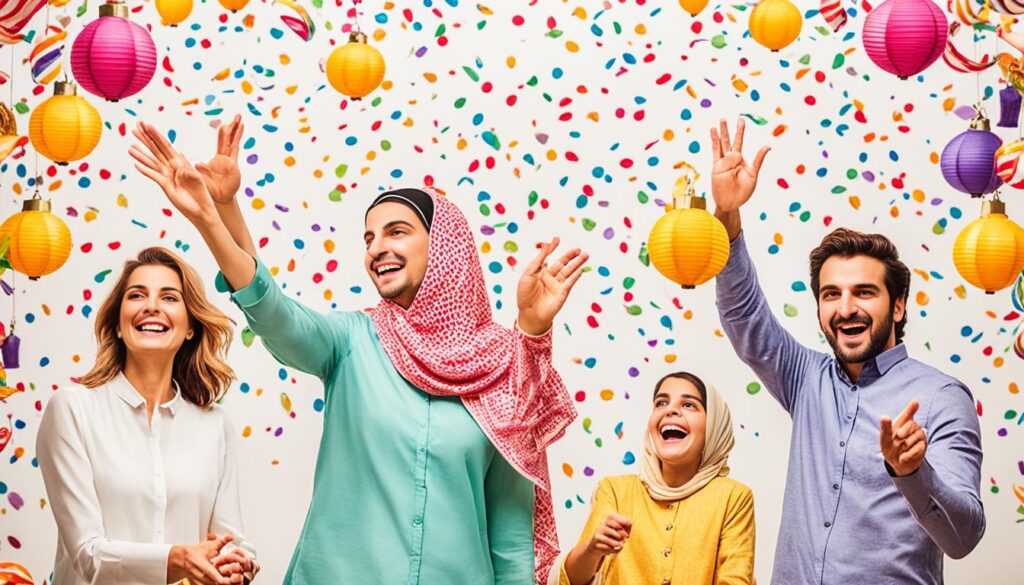
Importance of Grateful Responses
“Khair Mubarak” and “JazakAllah Khair” are popular responses to Eid Mubarak, reflecting the Islamic values of gratitude and appreciation. These responses not only acknowledge the good wishes received but also serve as an opportunity to express blessings back to the individual who offered the greeting.”
Different Ways to Wish Eid Mubarak
Eid Mubarak wishes can vary based on language and culture. It’s fascinating to see how people from different regions and communities express their well-wishes during this joyous occasion. Here are some examples of Eid Mubarak greetings in various languages:
Arabic-Speaking Regions
In Arab countries, people commonly use the phrases “Eid Saeed” or “Kul ‘aam wa antum bi’khair” to wish Eid Mubarak. These expressions convey the meaning of a blessed Eid and well-wishes for the recipient.
Malay-Speaking Countries
In Malay-speaking countries such as Malaysia and Indonesia, individuals extend their greetings with the phrase “Selamat Hari Raya.” This expression encapsulates the spirit of celebrating Eid and wishing others a joyful holiday.
Albania and Kosovo
Albanian speakers use the phrase “Urime festa e fitër Bajramit” to convey their wishes for a blessed Feast of Breaking the Fast. Similarly, Kosovar speakers say “Urime kurban bajrami” to wish others a happy Eid al-Adha, the Festival of Sacrifice.
These examples demonstrate the diversity of languages and cultures within the global Muslim community. Regardless of the language, the sentiment behind these greetings remains the same – spreading joy, love, and goodwill.
If you have friends or family members from different linguistic backgrounds, using their native Eid greetings can be a thoughtful way to connect and share the spirit of Eid Mubarak.
Significance of Moon Sightings for Determining Eid Date
The sighting of the moon plays a significant role in determining the date of Eid. Muslims around the world eagerly await the sighting of the new moon, which signals the beginning of the lunar month of Shawwal and the celebration of Eid al-Fitr. However, there are regional variations in moon sighting practices, leading to debates and discussions within the Muslim community.
Some Muslims believe that moon sightings should be based on local observations, with each community or region independently determining the start of Eid. Others, however, follow established sightings in countries such as Saudi Arabia, which has historically held a prominent role in announcing the beginning of the Islamic months. The debate arises from the question of whether local sightings should take precedence over centralized announcements.
In Saudi Arabia, the sighting of the moon is given great importance. The Supreme Court relies on testimonies from credible witnesses to determine the start of the month. Once the moon is sighted and confirmed, the official announcement is made, marking the beginning of Eid. This practice is observed by Muslims not only in Saudi Arabia but also in many other countries that follow the Saudi calendar.
In Iran, the moon sighting process is central to determining the official start of Eid. The country relies on its own Islamic calendar and the observations of experts to announce the sighting of the new moon. Similarly, in Iraq, the influential cleric Ayatollah Ali al-Sistani’s announcement regarding the moon sighting is followed by the Iraqi Muslim community.
“The new moon’s sighting holds great significance for Muslims around the world as it sets the dates for the joyful celebrations of Eid al-Fitr. While some rely on local observances to determine the Eid date, others adhere to established sightings in countries like Saudi Arabia, Iran, or follow the guidance of influential religious leaders. The regional variations in moon sighting practices reflect the diverse traditions and interpretations within the Muslim community.”
Moon sighting for determining the Eid date remains a topic of discussion and reflection for Muslims. Whether relying on local observations or following the practices of specific regions, the goal is to align with the spirit of unity and celebrate Eid collectively. While debates may continue, the significance of the moon sighting as a symbol of marking the auspicious occasion of Eid remains unchanged.
| Country | Moon Sighting Process |
|---|---|
| Saudi Arabia | Relies on testimonies from credible witnesses to determine the sighting of the moon |
| Iran | Relies on its own Islamic calendar and expert observations to announce the moon sighting |
| Iraq | Follows the announcement of influential cleric Ayatollah Ali al-Sistani regarding the moon sighting |
Understanding the regional variations in moon sighting practices provides insight into the diverse traditions and interpretations within the Muslim community. While the debate continues, the shared goal of commemorating Eid and celebrating the completion of Ramadan unites Muslims around the world. The moon remains a symbol of hope, renewal, and the beginning of a joyous period of festivities.
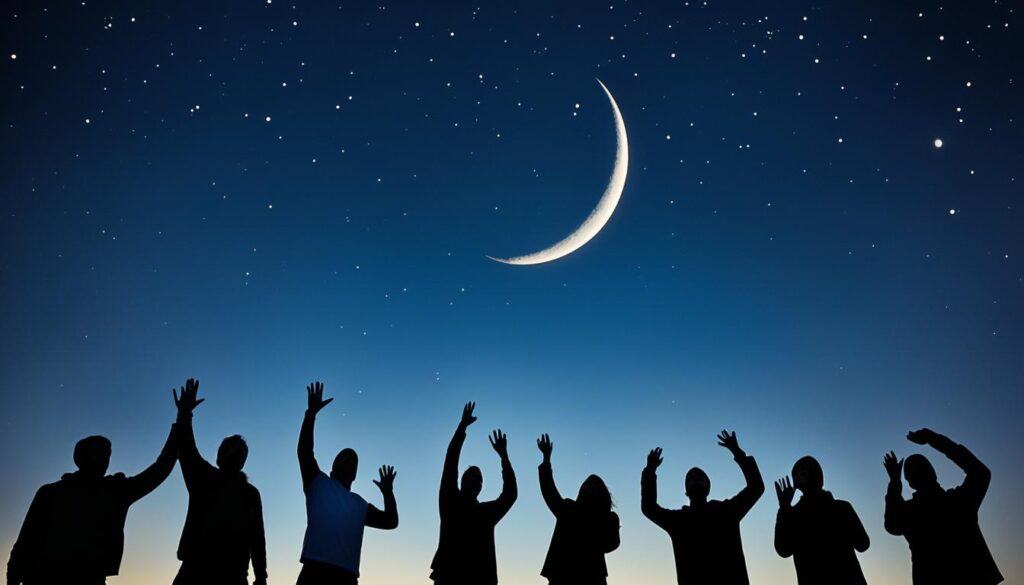
The Celebration of Eid al-Fitr
Eid al-Fitr, the Festival of Breaking the Fast, is a joyous occasion celebrated by Muslims worldwide. This important religious holiday marks the end of Ramadan, the month-long period of fasting and spiritual reflection. The celebration of Eid al-Fitr is a time for Muslims to come together, express gratitude, and revel in the blessings bestowed upon them.
One of the central elements of Eid al-Fitr is the Eid prayer. In the early morning, Muslims gather in mosques or outdoor prayer grounds to participate in the special congregational prayer. This prayer serves as a communal expression of gratitude and unity, as Muslims stand shoulder to shoulder in worship.
After the Eid prayer, the day is filled with gatherings, where families and friends come together to share in the joyous spirit of the occasion. It is customary for Muslims to dress in new clothes as a sign of renewal and to demonstrate their commitment to presenting their best selves during this auspicious celebration.
Feasting is an integral part of Eid al-Fitr. Following the prayer and gatherings, families partake in lavish meals that include traditional dishes and special sweet treats. It is a time to indulge in culinary delights and embrace the spirit of abundance and generosity.
Communities around the world organize large-scale events to celebrate Eid al-Fitr. These events often feature stalls selling traditional goods, live performances, and cultural activities. It’s an opportunity for people of different backgrounds to come together, learn from one another, and celebrate the diversity of Muslim traditions.
Some Muslims choose to observe an additional fast of six days after Eid al-Fitr. This practice, known as the sunnah fast, is seen as an extension of the spiritual devotion experienced during Ramadan. It allows individuals to continue their spiritual journey even after the month of fasting has concluded.
Eid al-Fitr is a time of joy, love, and gratitude. It is an occasion for Muslims to come together, strengthen bonds with loved ones, and reflect on the blessings bestowed upon them. From the early morning prayers to the festive gatherings and feasts, the celebration of Eid al-Fitr embodies the spirit of unity and appreciation for the abundant blessings in life.
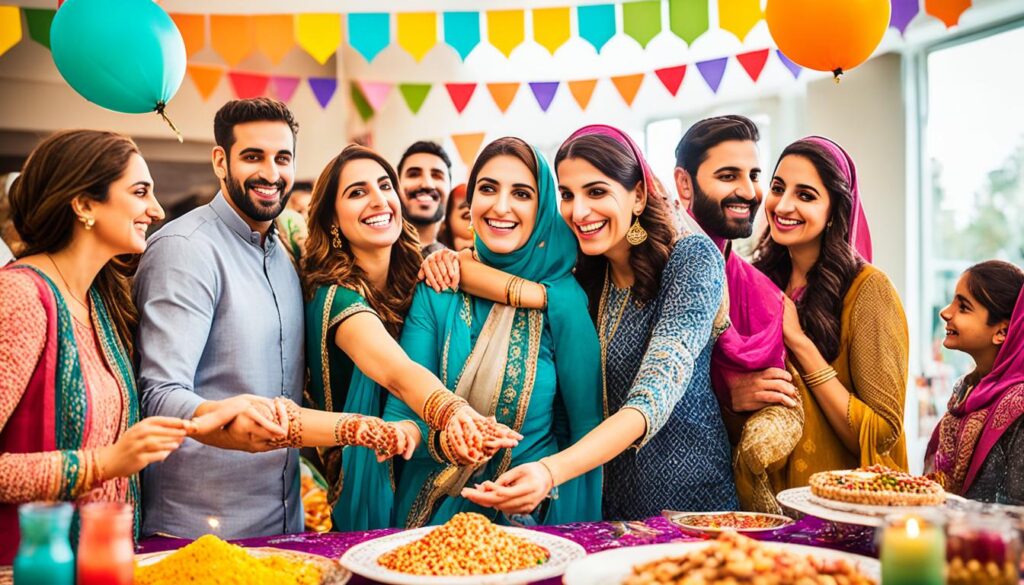
Conclusion
Eid Mubarak is a heartfelt greeting used to celebrate the joyous occasions of Eid al-Fitr and Eid al-Adha. It is a way for Muslims to express blessings and well-wishes to one another during these important festivals. The phrase “Eid Mubarak” holds cultural significance beyond its literal meaning, as it fosters inclusivity among different cultures and promotes unity.
Throughout different regions and communities, there are varying ways to wish others Eid Mubarak, showcasing the richness of cultural diversity. Responding to Eid Mubarak with gratitude is customary and appreciated, as it strengthens the bonds of friendship and respect.
The sighting of the moon plays a crucial role in determining the date of Eid, highlighting the importance of lunar observations in the Islamic calendar. The celebrations of Eid al-Fitr are marked by prayers, gatherings with loved ones, and feasting on special meals, including delectable sweet treats.
In essence, Eid Mubarak serves as a symbol of unity and respect within the Muslim community and extends beyond to people of diverse backgrounds. It encapsulates the spirit of joy, kindness, and harmony, making it a cherished tradition during the Eid festivals.
FAQ
What does Eid Mubarak mean?
What are the regional variations of Eid Mubarak?
Can Eid Mubarak be used by non-Muslims?
How should Eid Mubarak be used? How do you pronounce it?
What is Eid al-Fitr?
How should one respond to Eid Mubarak?
What are some different ways to wish Eid Mubarak?
How significant are moon sightings for determining the date of Eid?
How is Eid al-Fitr celebrated?
How is Understanding Employee Supervision Related to Understanding the Meaning of “Eid Mubarak”?
Understanding employee supervision explained is crucial for successful teamwork, just as understanding the meaning of “Eid Mubarak” is essential for cultural awareness and inclusivity in the workplace. Both require empathy, respect, and a willingness to learn from each other’s perspectives to create a harmonious and productive environment.

